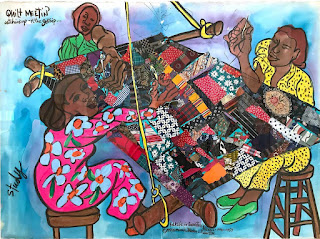In this image titled, “Christmas in Poindexter Village” Ohio artist Aminah Brenda Lynn Robinson depicts a public housing community in Columbus where she grew up. In her unique handmade books, Aminah explores the history of her family, her community and Black Americans.
The Toledo Museum of Art used this picture on their facebook page to wish members and fans a Merry Christmas. It caught my eye, pulled me in, and inspired me to learn a bit more about Aminah Robinson, the artist.
 |
Aminah Brenda Lynn Robinson from the series Folk Costumes from the Blackberry Patch, featured in the exhibition "Raggin’ On: The Art of Aminah Brenda Lynn Robinson’s House and Journals," at the Columbus (Ohio) Museum of Art.
|
 |
Carole Miller Genshaft, CMA curator,
Ohio U Press, 2018, for children |
She was born on February 18, 1940, in Columbus, Ohio, and died at 75 years of age in 2015. She grew up in the Poindexter public housing community in Columbus, one of the first federally funded housing projects in the country. She started sketching from an early age, encouraged by her father and mother. "“By the time I reached 9 years old,” she wrote in one of her journals, “I was deep, deep into transforming and recording the culture of my people into works of art."
She attended the Columbus College of Art and Design and worked on her art diligently, inspired by the stories of African Americans in her community, as well as the history of the Black experience in America. "She believed that life for her people in America was 'an act of near-superhuman perseverance,' and she was determined to capture that history in every medium she could" (note 5 below).
Her entire oeuvre--including paintings, sculpture, mixed-.media using objects from nature, buttons and found materials, multi-layered portraits, drawings and books from the writing in her journals--is a testament to this determination, driven to work daily from sun up to sun down until her death in the home she turned into a vibrant artist's studio. A MacArthur Genius Award in 2005 enabled her to work as a full-time artist. Her work took off and flourished. She travelled to Africa and other countries, became a force in her Columbus community, was a Civil Rights artist activist, influenced a new generation of artists, and developed a close and fruitful relationship with the Columbus Museum or Art (CMA).
 |
Aminah Robinson, "Bo Walking the First Family through the Rose Garden,"
Columbus Museum of Art. Robinson soared with hope and joy when
Obama was elected president, a dream toward which she had long worked
as a dedicated Civil Rights activist. She marched with Martin Luther King at the
1963 March on Washington.
Upon her death, Robinson bequeathed all her art and her house to the CMA. The museum spent years carefully documenting her art, writings, archive and library that remained in her house. A trusted steward, the museum mounted the first major exhibition of her work in November 2020, delayed due to Covid, called "Raggin' On: The Art of Aminah Brenda Lynn Robinson (1940-2015)." This exhibition, co-curated by Carole Miller Genshaft, presented six decades of Robinson's art and writings. Thoughtful and deliberate, the museum invited visitors to experience the artist's house and creative processes and to better understand her intention "to celebrate the everyday lives and culture of Black people and their endurance through centuries of injustice."
Aminah Robinson's work is now held by several other museums, part of their permanent collections, including the Brooklyn Museum of Art, the Smithsonian National Museum of Art, and our own Toledo Museum of Art.
"Symphonic Poem," part of a series, so powerful and moving, like all Aminah Robinson's work.
On this first day of Kwanzsa, TMA posted a piece of art from another great African-American artist, Romare Bearden (below). It's titled "Family Gathering." I remember discovering Bearden at the National Gallery of Art in Washington, DC, and have never forgotten it, or the impact the work of this fabulous artist had on me. Aminah Robinson clearly stands proudly in the iconic tradition of Romare Bearden, along with Jacob Lawrence, Alma Thomas, folk artists like Mary Proctor and the Florida Highwaymen and Woman, Gordon Parks, William H. Johnson, Lois Mailou Jones, Beauford Delaney, to mention only a few. It is an august tradition that expands the traditional canon and opens our eyes to a whole universe of experience and culture that all Americans should understand and embrace. It is as well a fitting tribute to Desmond Tutu, the friend of Nelson Mandela and voice for justice, who died today and whose loss we grieve.
|
Sources/Notes
1. https://www.columbusmuseum.org/blog/tag/aminah-robinson
2. Carole Miller Genshaft, Aminah's World, Ohio U Press, 2018. A book for children about the artist.
3. https://en.wikipedia.org/wiki/Aminah_Robinson
4. https://www.npr.org/2021/10/01/1041301066/buttons-beads-and-bravado-celebrating-the-simple-joy-in-aminah-robinsons-art
5. https://www.nytimes.com/2021/02/26/obituaries/aminah-brenda-lynn-robinson-overlooked.html
6. https://www.columbusmuseum.org/blog/news_room/raggin-on-features-new-work-by-beloved-artist
7.
A History of African-American Artists by Romare Bearden and Harry Henderson.
8. African-American Art and Artists by Samella Lewis, U. of Cafifornia Press, 2013.
9. Another good source is art historian Richard Powell, a Duke University professor of Art history, who wrote on the African-American tradition in important ways after his wonderful book on William H. Johnson. I knew Richard in DC and admired his critically important work at the time, and still do. See Richard J. Powell Was Once Among Only a Handful of Scholars Dedicated to Black Art History. Here's How He Has Seen the Field Change (artnet.com).
10. https://www.washingtonpost.com/local/obituaries/desmond-tutu-archbishop-south-africa-apartheid/2021/12/26/9fef6f0c-661e-11ec-a7e8-3a8455b71fad_story.html.












No comments:
Post a Comment